MSWPG7108: Reflective Report on Group Experience in Social Work
VerifiedAdded on 2023/06/04
|6
|1519
|395
Report
AI Summary
This report reflects on the experience of participating in a voluntary group sponsored by the ministry of social work, focusing on addressing health issues related to food safety and hygiene, as well as environmental concerns within a community setting. The report details the group's processes and stages, including recruitment, training, assessment of households, and community education. It also discusses the individual's role and the roles of other group members, particularly the coordinator's leadership style, and addresses conflicts that arose within the group and how they were mediated. The reflection incorporates theoretical models relevant to social work practice and highlights the importance of teamwork and communication skills in achieving the group's objectives, ultimately contributing to enhanced competencies in social work.
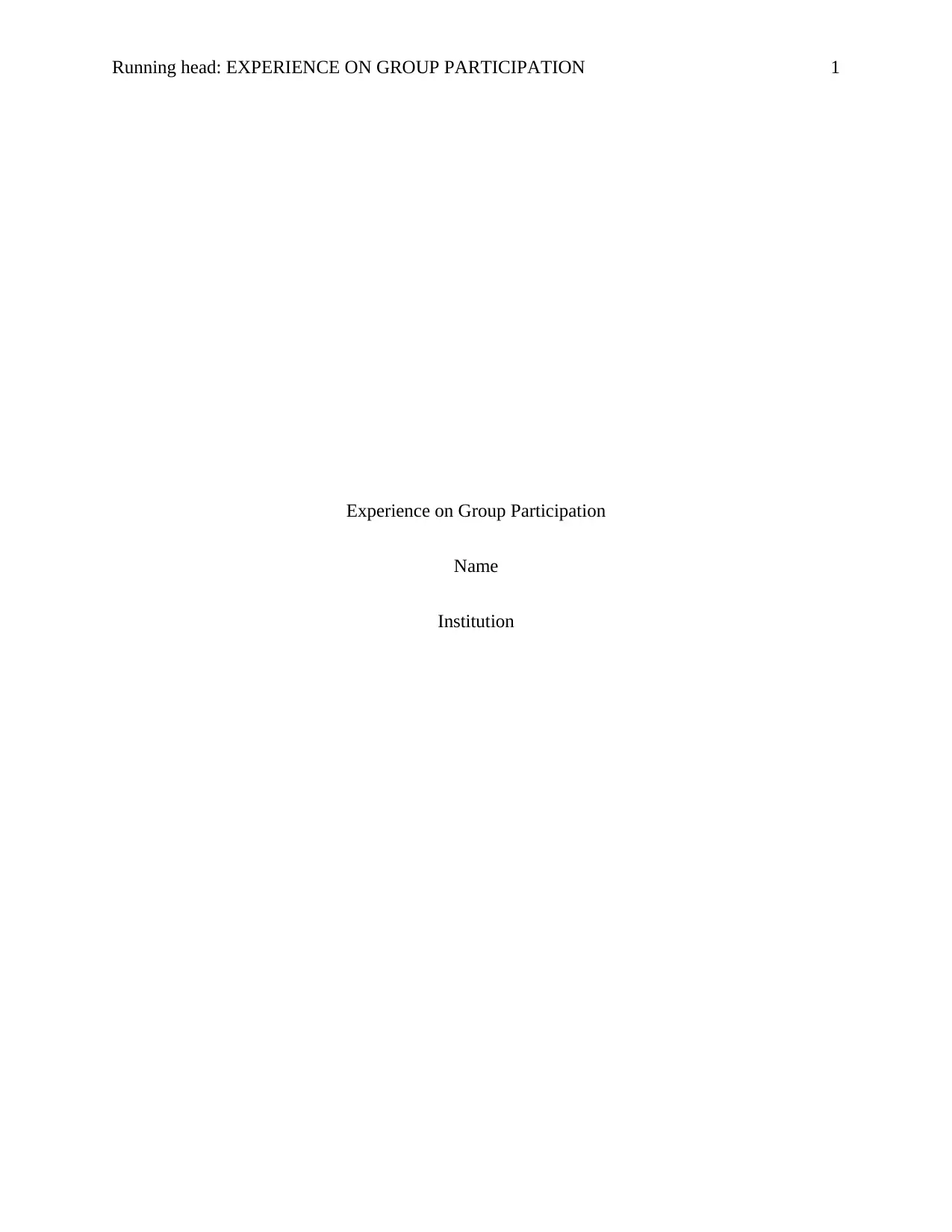
Running head: EXPERIENCE ON GROUP PARTICIPATION 1
Experience on Group Participation
Name
Institution
Experience on Group Participation
Name
Institution
Paraphrase This Document
Need a fresh take? Get an instant paraphrase of this document with our AI Paraphraser
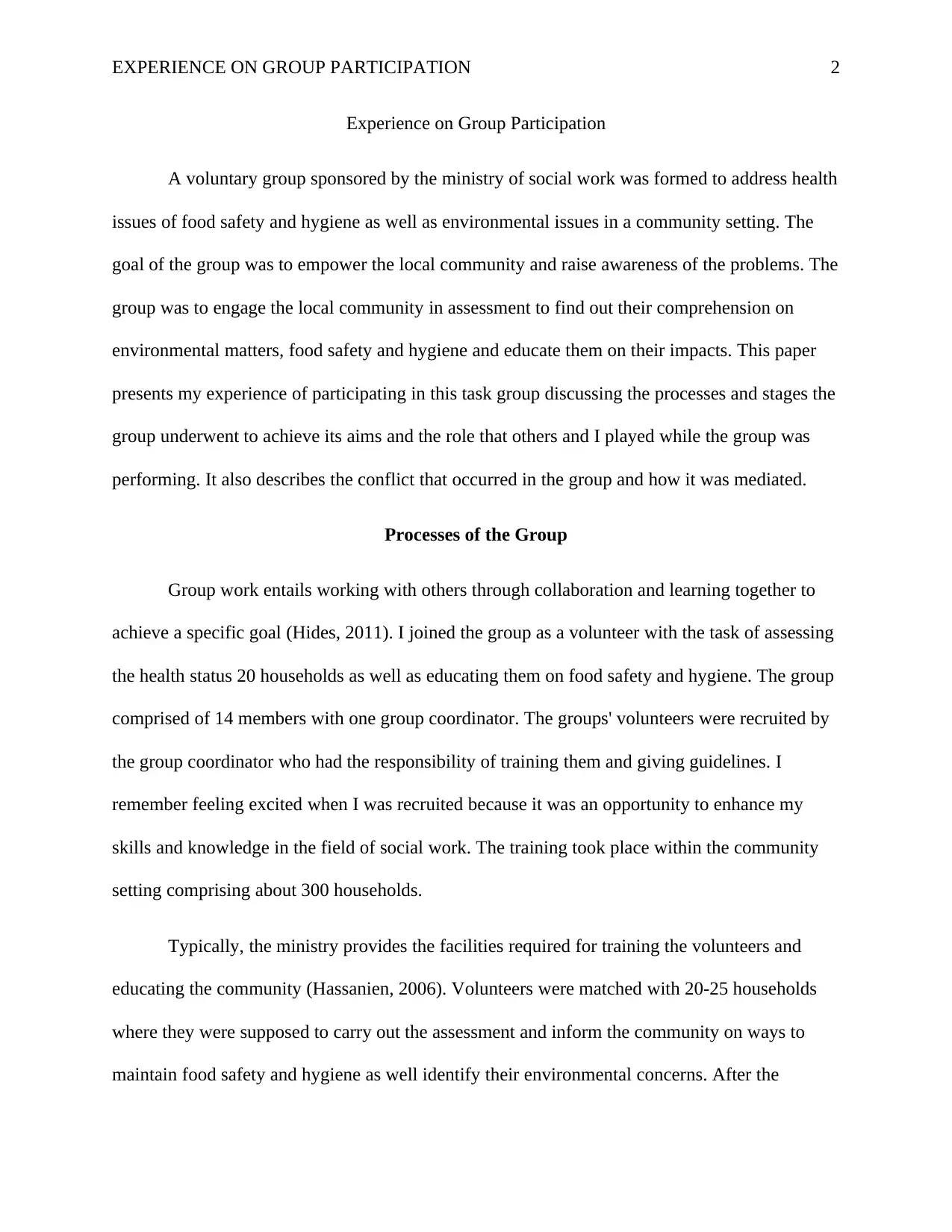
EXPERIENCE ON GROUP PARTICIPATION 2
Experience on Group Participation
A voluntary group sponsored by the ministry of social work was formed to address health
issues of food safety and hygiene as well as environmental issues in a community setting. The
goal of the group was to empower the local community and raise awareness of the problems. The
group was to engage the local community in assessment to find out their comprehension on
environmental matters, food safety and hygiene and educate them on their impacts. This paper
presents my experience of participating in this task group discussing the processes and stages the
group underwent to achieve its aims and the role that others and I played while the group was
performing. It also describes the conflict that occurred in the group and how it was mediated.
Processes of the Group
Group work entails working with others through collaboration and learning together to
achieve a specific goal (Hides, 2011). I joined the group as a volunteer with the task of assessing
the health status 20 households as well as educating them on food safety and hygiene. The group
comprised of 14 members with one group coordinator. The groups' volunteers were recruited by
the group coordinator who had the responsibility of training them and giving guidelines. I
remember feeling excited when I was recruited because it was an opportunity to enhance my
skills and knowledge in the field of social work. The training took place within the community
setting comprising about 300 households.
Typically, the ministry provides the facilities required for training the volunteers and
educating the community (Hassanien, 2006). Volunteers were matched with 20-25 households
where they were supposed to carry out the assessment and inform the community on ways to
maintain food safety and hygiene as well identify their environmental concerns. After the
Experience on Group Participation
A voluntary group sponsored by the ministry of social work was formed to address health
issues of food safety and hygiene as well as environmental issues in a community setting. The
goal of the group was to empower the local community and raise awareness of the problems. The
group was to engage the local community in assessment to find out their comprehension on
environmental matters, food safety and hygiene and educate them on their impacts. This paper
presents my experience of participating in this task group discussing the processes and stages the
group underwent to achieve its aims and the role that others and I played while the group was
performing. It also describes the conflict that occurred in the group and how it was mediated.
Processes of the Group
Group work entails working with others through collaboration and learning together to
achieve a specific goal (Hides, 2011). I joined the group as a volunteer with the task of assessing
the health status 20 households as well as educating them on food safety and hygiene. The group
comprised of 14 members with one group coordinator. The groups' volunteers were recruited by
the group coordinator who had the responsibility of training them and giving guidelines. I
remember feeling excited when I was recruited because it was an opportunity to enhance my
skills and knowledge in the field of social work. The training took place within the community
setting comprising about 300 households.
Typically, the ministry provides the facilities required for training the volunteers and
educating the community (Hassanien, 2006). Volunteers were matched with 20-25 households
where they were supposed to carry out the assessment and inform the community on ways to
maintain food safety and hygiene as well identify their environmental concerns. After the
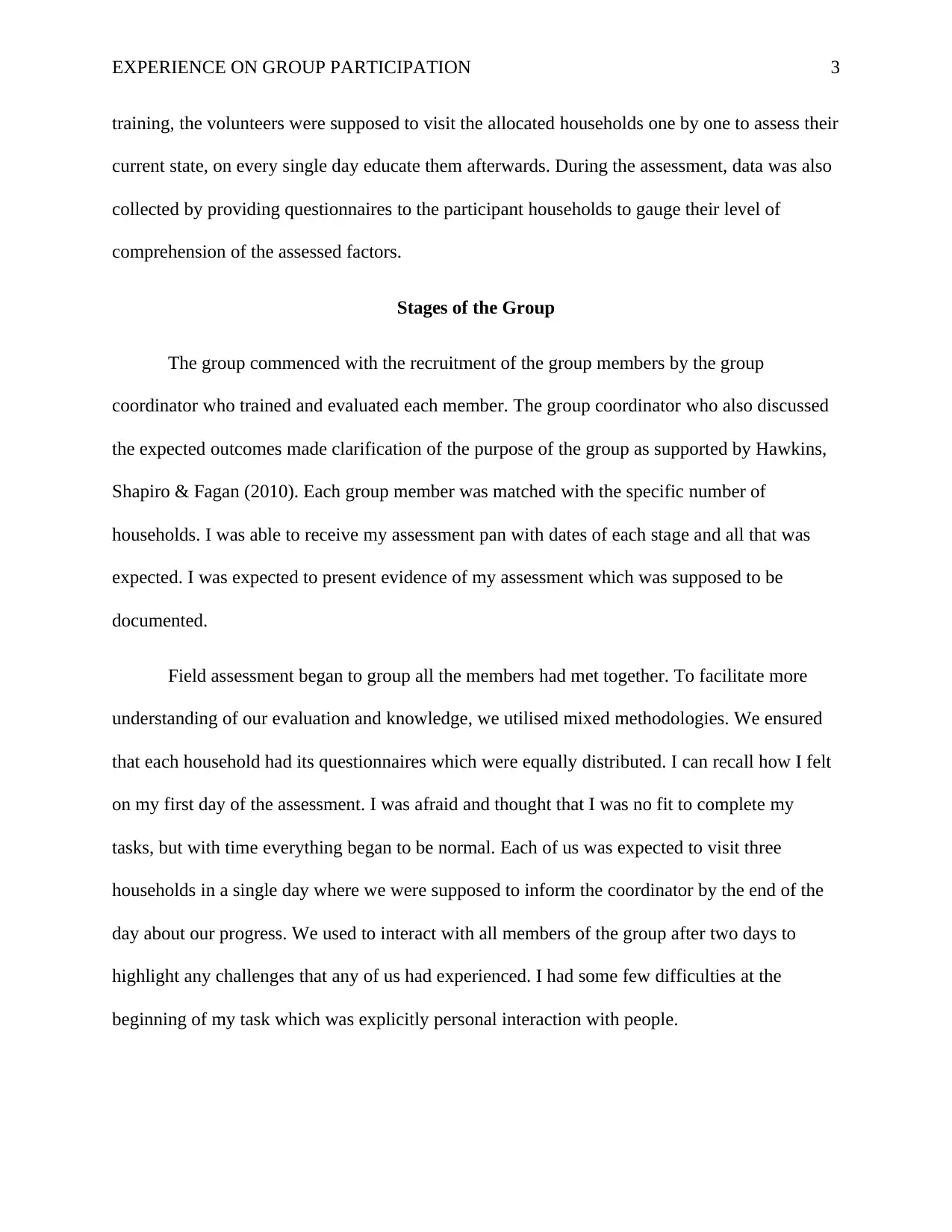
EXPERIENCE ON GROUP PARTICIPATION 3
training, the volunteers were supposed to visit the allocated households one by one to assess their
current state, on every single day educate them afterwards. During the assessment, data was also
collected by providing questionnaires to the participant households to gauge their level of
comprehension of the assessed factors.
Stages of the Group
The group commenced with the recruitment of the group members by the group
coordinator who trained and evaluated each member. The group coordinator who also discussed
the expected outcomes made clarification of the purpose of the group as supported by Hawkins,
Shapiro & Fagan (2010). Each group member was matched with the specific number of
households. I was able to receive my assessment pan with dates of each stage and all that was
expected. I was expected to present evidence of my assessment which was supposed to be
documented.
Field assessment began to group all the members had met together. To facilitate more
understanding of our evaluation and knowledge, we utilised mixed methodologies. We ensured
that each household had its questionnaires which were equally distributed. I can recall how I felt
on my first day of the assessment. I was afraid and thought that I was no fit to complete my
tasks, but with time everything began to be normal. Each of us was expected to visit three
households in a single day where we were supposed to inform the coordinator by the end of the
day about our progress. We used to interact with all members of the group after two days to
highlight any challenges that any of us had experienced. I had some few difficulties at the
beginning of my task which was explicitly personal interaction with people.
training, the volunteers were supposed to visit the allocated households one by one to assess their
current state, on every single day educate them afterwards. During the assessment, data was also
collected by providing questionnaires to the participant households to gauge their level of
comprehension of the assessed factors.
Stages of the Group
The group commenced with the recruitment of the group members by the group
coordinator who trained and evaluated each member. The group coordinator who also discussed
the expected outcomes made clarification of the purpose of the group as supported by Hawkins,
Shapiro & Fagan (2010). Each group member was matched with the specific number of
households. I was able to receive my assessment pan with dates of each stage and all that was
expected. I was expected to present evidence of my assessment which was supposed to be
documented.
Field assessment began to group all the members had met together. To facilitate more
understanding of our evaluation and knowledge, we utilised mixed methodologies. We ensured
that each household had its questionnaires which were equally distributed. I can recall how I felt
on my first day of the assessment. I was afraid and thought that I was no fit to complete my
tasks, but with time everything began to be normal. Each of us was expected to visit three
households in a single day where we were supposed to inform the coordinator by the end of the
day about our progress. We used to interact with all members of the group after two days to
highlight any challenges that any of us had experienced. I had some few difficulties at the
beginning of my task which was explicitly personal interaction with people.
⊘ This is a preview!⊘
Do you want full access?
Subscribe today to unlock all pages.

Trusted by 1+ million students worldwide
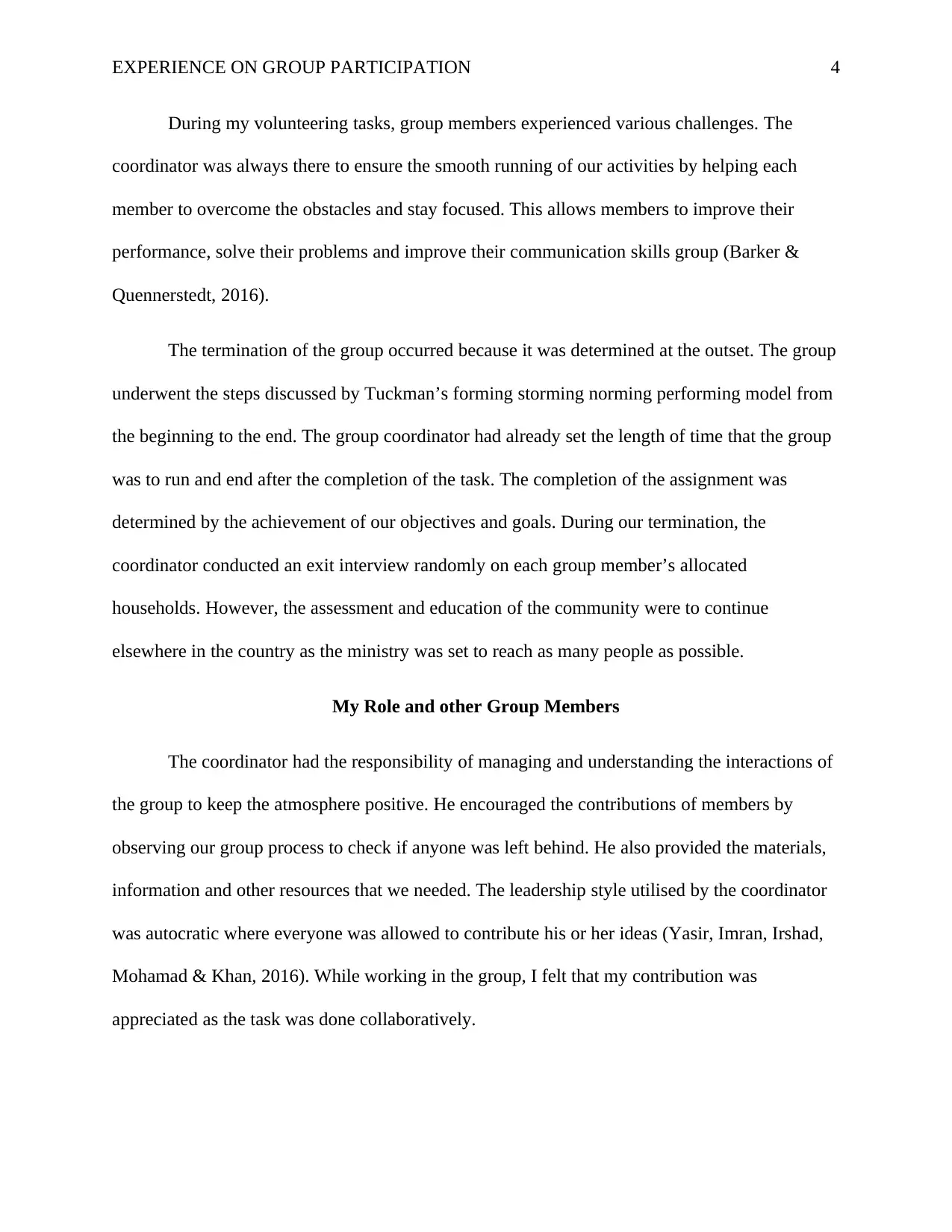
EXPERIENCE ON GROUP PARTICIPATION 4
During my volunteering tasks, group members experienced various challenges. The
coordinator was always there to ensure the smooth running of our activities by helping each
member to overcome the obstacles and stay focused. This allows members to improve their
performance, solve their problems and improve their communication skills group (Barker &
Quennerstedt, 2016).
The termination of the group occurred because it was determined at the outset. The group
underwent the steps discussed by Tuckman’s forming storming norming performing model from
the beginning to the end. The group coordinator had already set the length of time that the group
was to run and end after the completion of the task. The completion of the assignment was
determined by the achievement of our objectives and goals. During our termination, the
coordinator conducted an exit interview randomly on each group member’s allocated
households. However, the assessment and education of the community were to continue
elsewhere in the country as the ministry was set to reach as many people as possible.
My Role and other Group Members
The coordinator had the responsibility of managing and understanding the interactions of
the group to keep the atmosphere positive. He encouraged the contributions of members by
observing our group process to check if anyone was left behind. He also provided the materials,
information and other resources that we needed. The leadership style utilised by the coordinator
was autocratic where everyone was allowed to contribute his or her ideas (Yasir, Imran, Irshad,
Mohamad & Khan, 2016). While working in the group, I felt that my contribution was
appreciated as the task was done collaboratively.
During my volunteering tasks, group members experienced various challenges. The
coordinator was always there to ensure the smooth running of our activities by helping each
member to overcome the obstacles and stay focused. This allows members to improve their
performance, solve their problems and improve their communication skills group (Barker &
Quennerstedt, 2016).
The termination of the group occurred because it was determined at the outset. The group
underwent the steps discussed by Tuckman’s forming storming norming performing model from
the beginning to the end. The group coordinator had already set the length of time that the group
was to run and end after the completion of the task. The completion of the assignment was
determined by the achievement of our objectives and goals. During our termination, the
coordinator conducted an exit interview randomly on each group member’s allocated
households. However, the assessment and education of the community were to continue
elsewhere in the country as the ministry was set to reach as many people as possible.
My Role and other Group Members
The coordinator had the responsibility of managing and understanding the interactions of
the group to keep the atmosphere positive. He encouraged the contributions of members by
observing our group process to check if anyone was left behind. He also provided the materials,
information and other resources that we needed. The leadership style utilised by the coordinator
was autocratic where everyone was allowed to contribute his or her ideas (Yasir, Imran, Irshad,
Mohamad & Khan, 2016). While working in the group, I felt that my contribution was
appreciated as the task was done collaboratively.
Paraphrase This Document
Need a fresh take? Get an instant paraphrase of this document with our AI Paraphraser
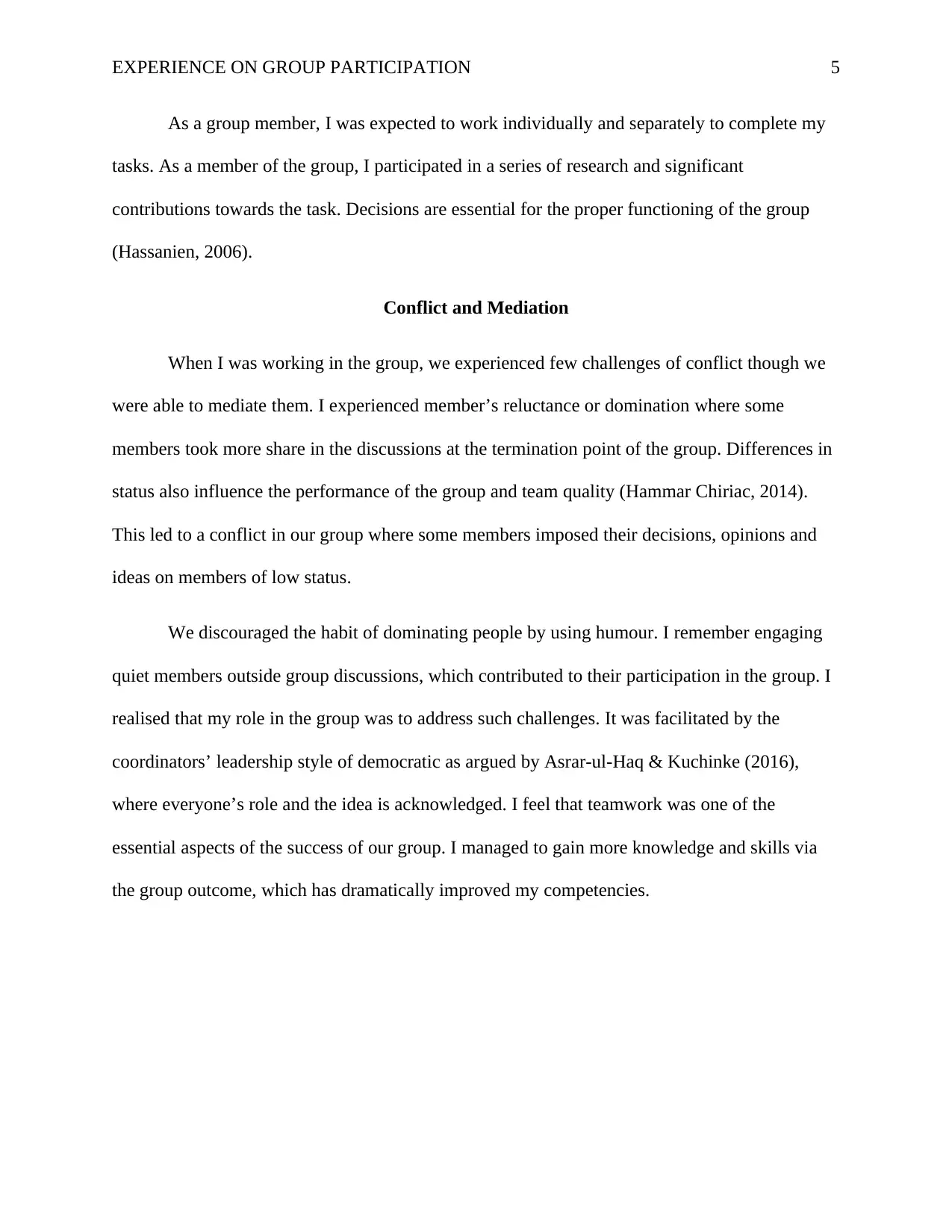
EXPERIENCE ON GROUP PARTICIPATION 5
As a group member, I was expected to work individually and separately to complete my
tasks. As a member of the group, I participated in a series of research and significant
contributions towards the task. Decisions are essential for the proper functioning of the group
(Hassanien, 2006).
Conflict and Mediation
When I was working in the group, we experienced few challenges of conflict though we
were able to mediate them. I experienced member’s reluctance or domination where some
members took more share in the discussions at the termination point of the group. Differences in
status also influence the performance of the group and team quality (Hammar Chiriac, 2014).
This led to a conflict in our group where some members imposed their decisions, opinions and
ideas on members of low status.
We discouraged the habit of dominating people by using humour. I remember engaging
quiet members outside group discussions, which contributed to their participation in the group. I
realised that my role in the group was to address such challenges. It was facilitated by the
coordinators’ leadership style of democratic as argued by Asrar-ul-Haq & Kuchinke (2016),
where everyone’s role and the idea is acknowledged. I feel that teamwork was one of the
essential aspects of the success of our group. I managed to gain more knowledge and skills via
the group outcome, which has dramatically improved my competencies.
As a group member, I was expected to work individually and separately to complete my
tasks. As a member of the group, I participated in a series of research and significant
contributions towards the task. Decisions are essential for the proper functioning of the group
(Hassanien, 2006).
Conflict and Mediation
When I was working in the group, we experienced few challenges of conflict though we
were able to mediate them. I experienced member’s reluctance or domination where some
members took more share in the discussions at the termination point of the group. Differences in
status also influence the performance of the group and team quality (Hammar Chiriac, 2014).
This led to a conflict in our group where some members imposed their decisions, opinions and
ideas on members of low status.
We discouraged the habit of dominating people by using humour. I remember engaging
quiet members outside group discussions, which contributed to their participation in the group. I
realised that my role in the group was to address such challenges. It was facilitated by the
coordinators’ leadership style of democratic as argued by Asrar-ul-Haq & Kuchinke (2016),
where everyone’s role and the idea is acknowledged. I feel that teamwork was one of the
essential aspects of the success of our group. I managed to gain more knowledge and skills via
the group outcome, which has dramatically improved my competencies.
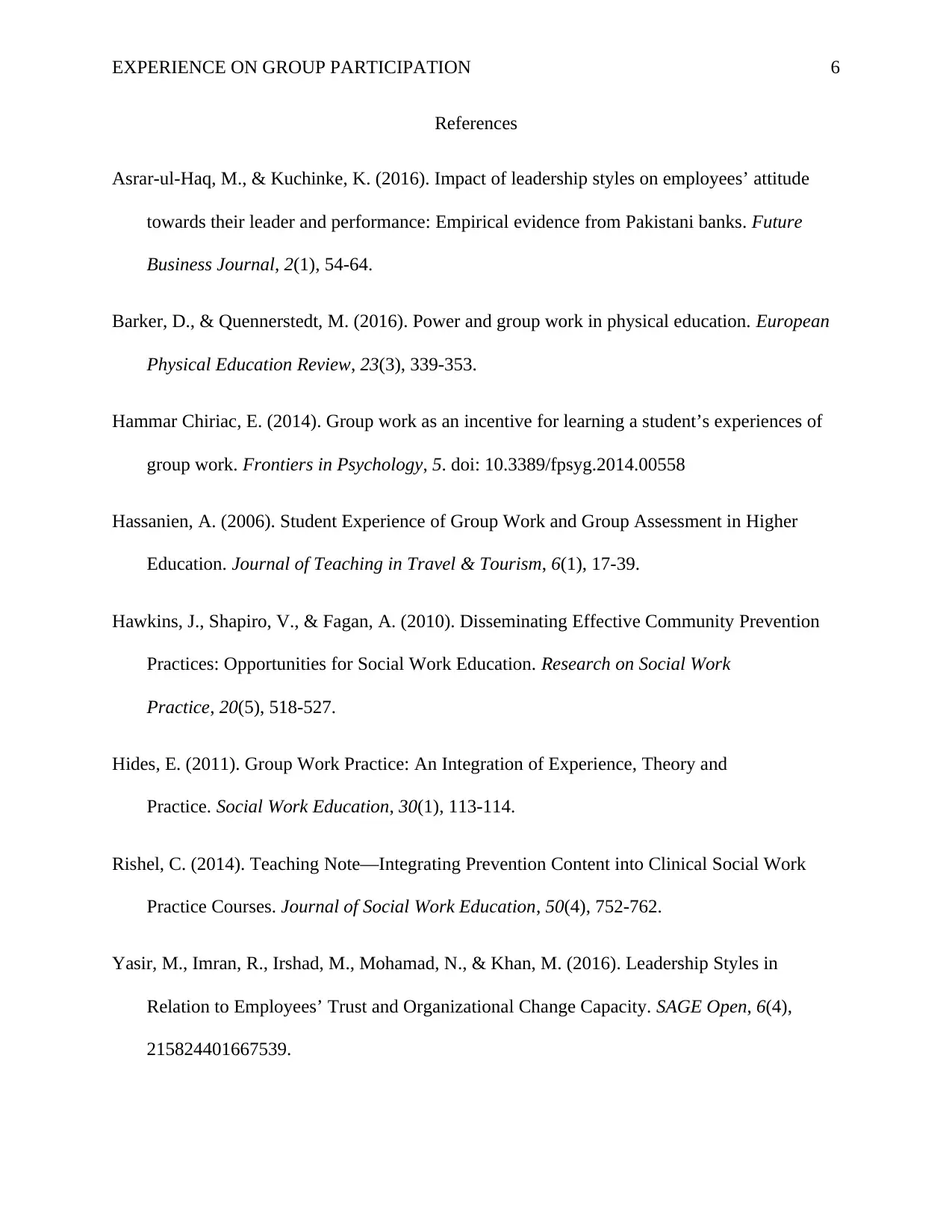
EXPERIENCE ON GROUP PARTICIPATION 6
References
Asrar-ul-Haq, M., & Kuchinke, K. (2016). Impact of leadership styles on employees’ attitude
towards their leader and performance: Empirical evidence from Pakistani banks. Future
Business Journal, 2(1), 54-64.
Barker, D., & Quennerstedt, M. (2016). Power and group work in physical education. European
Physical Education Review, 23(3), 339-353.
Hammar Chiriac, E. (2014). Group work as an incentive for learning a student’s experiences of
group work. Frontiers in Psychology, 5. doi: 10.3389/fpsyg.2014.00558
Hassanien, A. (2006). Student Experience of Group Work and Group Assessment in Higher
Education. Journal of Teaching in Travel & Tourism, 6(1), 17-39.
Hawkins, J., Shapiro, V., & Fagan, A. (2010). Disseminating Effective Community Prevention
Practices: Opportunities for Social Work Education. Research on Social Work
Practice, 20(5), 518-527.
Hides, E. (2011). Group Work Practice: An Integration of Experience, Theory and
Practice. Social Work Education, 30(1), 113-114.
Rishel, C. (2014). Teaching Note—Integrating Prevention Content into Clinical Social Work
Practice Courses. Journal of Social Work Education, 50(4), 752-762.
Yasir, M., Imran, R., Irshad, M., Mohamad, N., & Khan, M. (2016). Leadership Styles in
Relation to Employees’ Trust and Organizational Change Capacity. SAGE Open, 6(4),
215824401667539.
References
Asrar-ul-Haq, M., & Kuchinke, K. (2016). Impact of leadership styles on employees’ attitude
towards their leader and performance: Empirical evidence from Pakistani banks. Future
Business Journal, 2(1), 54-64.
Barker, D., & Quennerstedt, M. (2016). Power and group work in physical education. European
Physical Education Review, 23(3), 339-353.
Hammar Chiriac, E. (2014). Group work as an incentive for learning a student’s experiences of
group work. Frontiers in Psychology, 5. doi: 10.3389/fpsyg.2014.00558
Hassanien, A. (2006). Student Experience of Group Work and Group Assessment in Higher
Education. Journal of Teaching in Travel & Tourism, 6(1), 17-39.
Hawkins, J., Shapiro, V., & Fagan, A. (2010). Disseminating Effective Community Prevention
Practices: Opportunities for Social Work Education. Research on Social Work
Practice, 20(5), 518-527.
Hides, E. (2011). Group Work Practice: An Integration of Experience, Theory and
Practice. Social Work Education, 30(1), 113-114.
Rishel, C. (2014). Teaching Note—Integrating Prevention Content into Clinical Social Work
Practice Courses. Journal of Social Work Education, 50(4), 752-762.
Yasir, M., Imran, R., Irshad, M., Mohamad, N., & Khan, M. (2016). Leadership Styles in
Relation to Employees’ Trust and Organizational Change Capacity. SAGE Open, 6(4),
215824401667539.
⊘ This is a preview!⊘
Do you want full access?
Subscribe today to unlock all pages.

Trusted by 1+ million students worldwide
1 out of 6
Related Documents
Your All-in-One AI-Powered Toolkit for Academic Success.
+13062052269
info@desklib.com
Available 24*7 on WhatsApp / Email
![[object Object]](/_next/static/media/star-bottom.7253800d.svg)
Unlock your academic potential
Copyright © 2020–2025 A2Z Services. All Rights Reserved. Developed and managed by ZUCOL.




